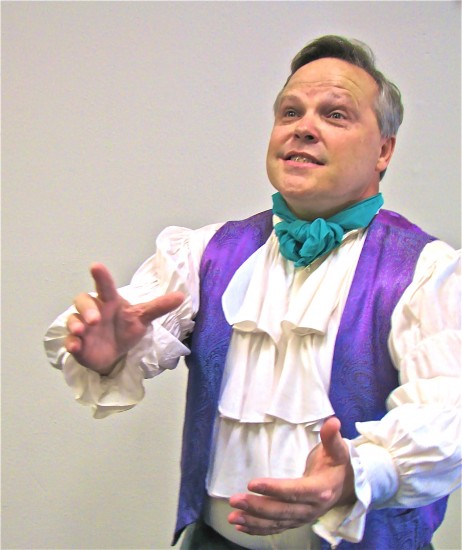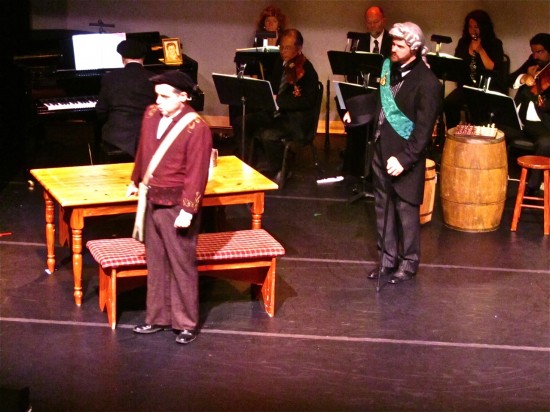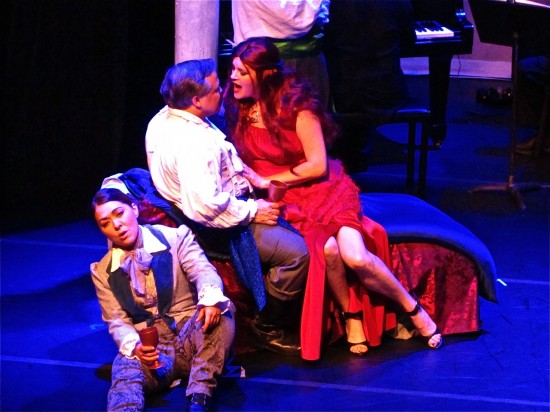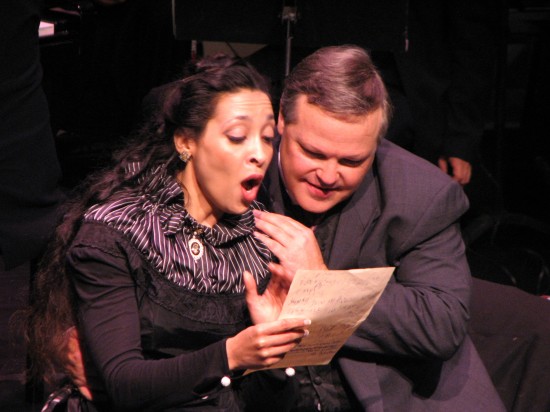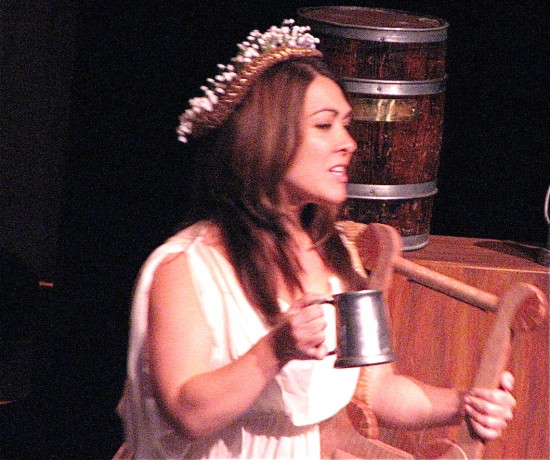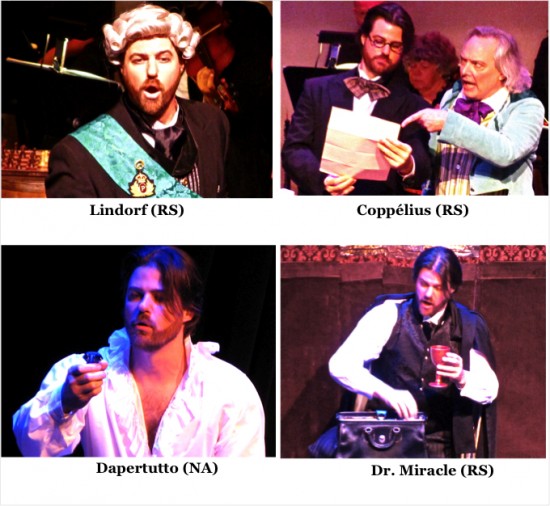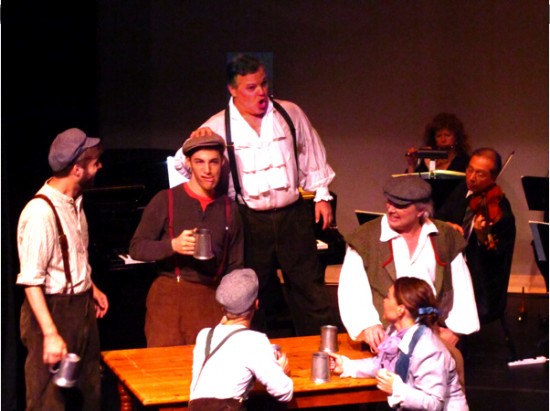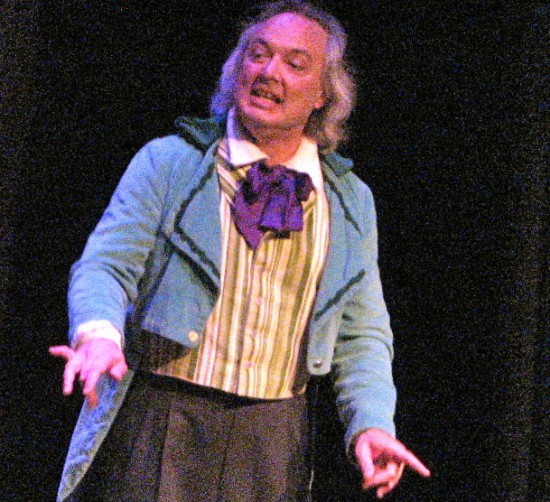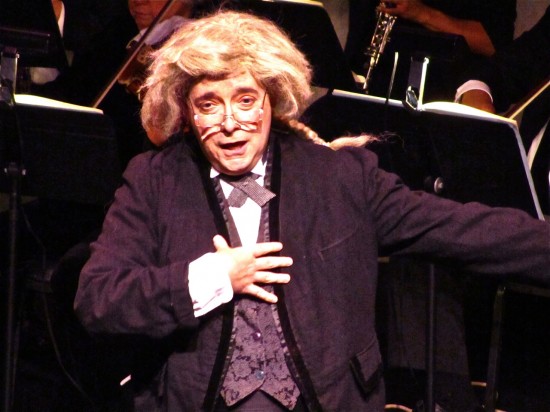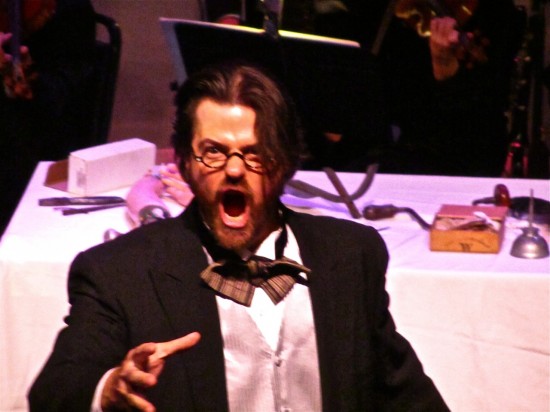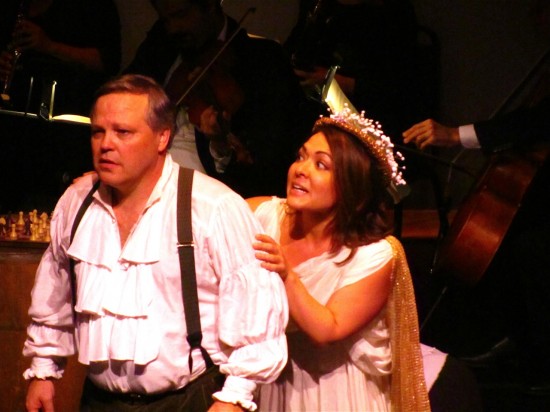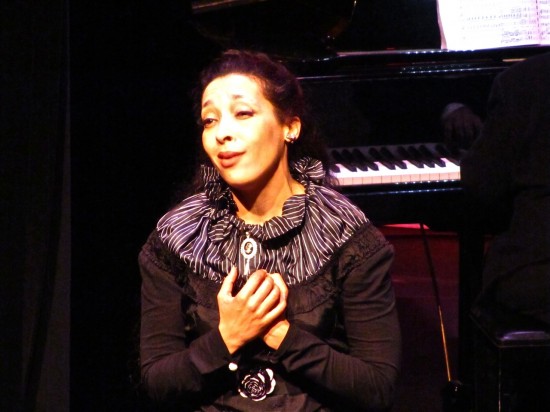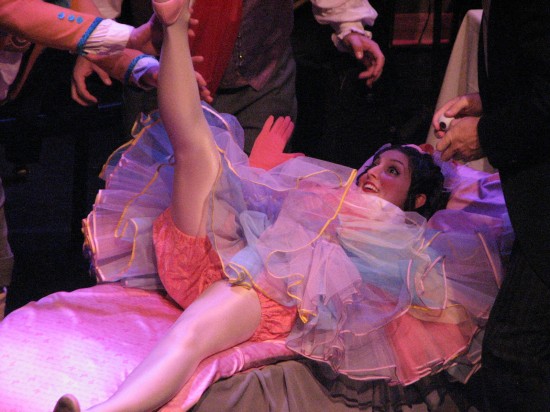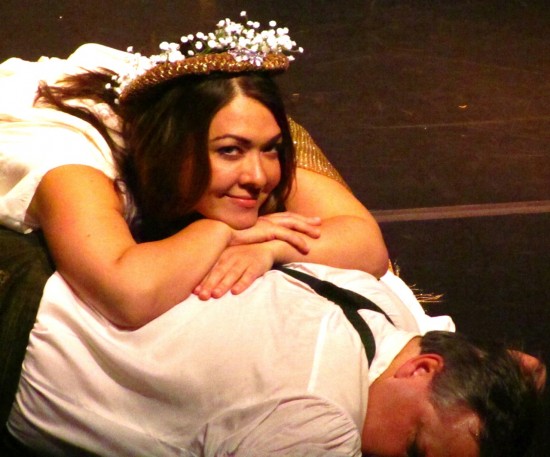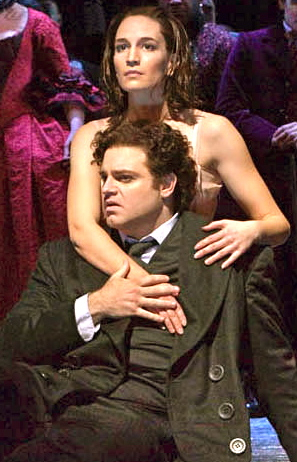The Opera-year 2012-13 promises to be a banner year for one of my favorite operas. On July 11 I saw a MetHD Encore performance from their 2009-10 season with Joseph Calleja, Kate Lindsey, Anna Netrebko, and Kathleen Kim; last Sunday, July 22, I saw the subject of today’s review and I plan to see it again on August 5; this September West Bay Opera tackles it; and next spring it’s on the program of the San Francisco Opera with Natalie Desai singing the role of Antonia.
Jacques Offenbach wrote almost 100 “operas” in his lifetime, but more than half of them were 1-Act and all but 2 of them are now classified as “operettas”, the exceptions being Tales of Hoffmann, which premiered in 1881, and the recently rediscovered The Rhine Nixies (1864-5), which did not receive its first full-length production until 2002! There are many things about Tales of Hoffmann that are unusual (if not unique) among operas, but I can best describe them by first giving you a condensed version of the plot.
The title character is a poet, and the opera is the story of his several loves. Offenbach considered it to consist of 5 acts, but modern performances all present it in 3 acts with the original first and last acts being relabeled as Prologue and Epilogue.
These both take place in a bar next door to the opera house just before and after the performance of a Mozart opera starring Stella, Hoffmann’s current love. A messenger from Stella enters with a note to Hoffmann setting a rendezvous after the opera and enclosing a key to her apartment. Hoffmann’s rival, Councilor Lindorf, bribes the messenger and gloatingly pockets the key.
The three intervening acts are each a flashback to one of Hoffmann’s previous tragic loves. In alphabetical order, these loves are Antonia, Giuliette, and Olympia. Since there is zero interaction between the three of them, the acts could be presented in any of the 6 possible permutations without any confusion, but in practice Olympia always appears in Act I. Offenbach’s order finished with Giuliette – indeed, Offenbach died before finishing her episode, and the premiere in 1881 had only Olympia and Antonia. Most productions in the early and mid 20th century put Giuliette in the middle and saved Antonia for last, but more recent productions have opted for historical verisimilitude and used Offenbach’s original order. The MetHD performance I saw and reviewed in 2009 and saw again earlier this month as a summer Encore performance used the O-A-G order, as did West Bay Opera in 2001. However Donald Pippin and his Pocket Opera have stayed with the O-G-A sequence, primarily because he strongly believes that it makes more sense musically.
Although I can enjoy and appreciate reasons for the validity of either sequence, I prefer O-G-A for emotional reasons. Taken in that order, they indicate an increasing maturity on the part of Hoffmann.
Olympia is not even a real person! She is a cleverly constructed robot, but with the aid of some magical glasses, Hoffmann sees her as real and falls in love. At the end of the act, she is dismantled and he sees incontrovertible evidence of her mechanical nature. He is devastated, but it would seem more from embarrassment at being duped than from genuine loss of a beloved woman. To me, the ending is farcical rather than tragic.
Giuliette is a real human, but she is a skilled courtesan, motivated entirely by greed rather than love. She is bribed to seduce Hoffmann and does so with the aid of her wonderful eyes. After she entraps him hook, line, and sinker, she tells him he first has to kill her current lover in a duel and take the key to her apartment from his pocket; she will be awaiting him there. But instead, she walks off arm-in-arm with a bit-player. Hoffmann is again devastated, but I can only feel “good riddance”. That was no love that he lost.
Antonia, on the other hand, is a genuine young woman. She and Hoffmann have fallen mutually and passionately in love before the act begins, but her father is opposed to Hoffmann and has taken her off to a place in the country. Antonia has inherited three things from her deceased mother: a beautiful voice, a love of music, and a strange disease in which the exertion of singing can prove fatal. There is no question; the emotional highlight of Tales of Hoffmann is the end of this act when Antonia sings (beautifully) – and dies. Hoffmann experiences genuine loss – and I empathize with him.
Regardless of the order of the previous acts, we are now back in the present in the Epilogue. Hoffmann has finished telling his three stories, and is thoroughly depressed. He finds solace in alcohol, and when Stella finishes her successful performance of the Mozart and enters Hoffmann is passed out, drunk. Stella, thinking he had received her note and was rejecting her, eyes him with disgust and willingly exits on the arm of Lindorf. Poor Hoffmann! A complete loser at the game of love.
But WAIT! There is a fifth love to be reckoned with – the love of Erato, the Muse of Poetry, for Hoffmann. We met this androgynous spirit in the form of an ethereal woman, visible only to us, the audience, early in the Prologue where she vowed to thwart Hoffmann in his mortal love affairs because he wrote only mushy drivel, if anything, whereas he could create sublime poetry when in the deepest despair.
Throughout all three acts of the opera his Muse appears as Hoffmann’s mortal companion Nicklausse, looking after his physical wellbeing but conspiring to foil his love affairs. Now, in the Epilogue the Muse reappears in female form to claim her love.
Hoffmann’s lack of success is not entirely his fault, since for each love he also has a Nemesis. And for the most part the Nemesis is delightfully ambiguous. Is his primary goal to destroy Hoffmann, or is the poet only an incidental obstacle as Nemesis pursues other selfish goals? More fundamentally, are there four distinct Nemeses or are they four different avatars of Satan?
Most productions lean towards the latter interpretation by casting the same bass-baritone singer for all four roles. In the Prologue and Epilogue, is Lindorf more interested in frustrating Hoffmann or in spending an evening of debauchery with Stella? In Act I Copp�lius appears to have a legitimate grievance, since Spalanzani, his co-inventor of the doll, has cheated him – but he does go out of his way to make a fool of Hoffmann. In each of the last two acts, it is clear that Nemesis is, indeed, an aspect of Satan. As Dapertutto he produces a gigantic jewel and bribes Giuliette to steal Hoffmann’s reflection. And as Dr. Miracle he shows off his power by tempting Antonia to literally sing herself to death, having previously killed her mother in the same way. Definitely not a nice guy.
OK. That’s enough about Tales of Hoffmann in general. Now, about the specific performance by Pocket Opera that I saw on Sunday, July 22, 2012. In a word, it was fantastic. Just looking at the program and seeing so many familiar names I knew we were in for something special. Three of the performers go back to Pocket Opera in the �90s at Temple Emanu-El.
J. Raymond Meyers has a magnificent tenor voice and was a great fit as Hoffmann. I can’t count the number of times I’ve seen him with Pocket Opera going back to when he was listed in the program as Joe Meyers.
Michael Mendelsohn is another real old-timer with Pocket Opera, but I’ve also seen him in many roles with Opera San Jos�. He does well in any role, but really shines in comedy. I spoke with him briefly after the performance and he was still bubbling over with enthusiasm for having played and sung Spalanzani “one of my favorite roles in all opera.” Although Spalanzani appears only in Act I, Michael could also be spotted in the chorus in most of the others – a real team player.
Andrew Morgan is the third old-timer who can be counted on to keep a straight face while bringing out the comic aspects in any role. He was the bribable messenger in the prologue, Spalanzani’s Assistant responsible for winding up Olympia, and the bit player who ended up with Giuliette. But he really shone as Franz, the deaf servant of Antonia’s father Crespel; he even has his own aria about how he could have been a great singer or dancer – while demonstrating that he doesn’t come close.
Lee Strawn is another old-timer who plays comic and dramatic roles with equal aplomb. Here he is three quite different characters: Luther the bartender; Schlemil, the Prussian-type former lover of Giuliette whom Hoffmann kills in a duel; and Antonia’s father Crespel.
Although this was Kirk Eichelberger’s debut with Pocket Opera, I have seen him countless times with Opera San Jos�, and in lead roles with West Bay Opera and Fremont Opera. He is an excellent actor and has a wonderful bass-baritone. There were several shouts of “Bravo” during his curtain call, but there were also numerous smiling calls of “Boooo”, obviously aimed not at Kirk but at the villains he portrayed so well.
Like Hoffmann, I have had – and still have – many loves. But whereas his loves were sequential and were devastatingly intense, my love for opera stars is completely spiritual (whatever that word means) and require no reciprocation or even recognition of my existence. I was already in love with Kindra Scharich from seeing her in other Pocket Opera performances, most recently last year as the feisty Isabella in The Italian Girl in Algiers, and her performance as the Muse did nothing to change my mind; she is a delight to watch and to listen to.
And I have also been in love with Erina Newkirk ever since seeing her last year as a vulnerable 15-year old in Act I of Pocket Opera’s Manon. As the beautiful, talented, and doomed Antonia, she tugged at my heartstrings in a quite different way.
Joining all of these veterans, and almost stealing the show as the doll Olympia, was Chelsea Hollow. Her soprano voice was true and clear but also had a seeming artificiality appropriate to that of a robot. And her robotic movements were uncannily realistic throughout her dance – and even more so when she toppled over from a sitting position with her legs remaining in the now totally absurd sitting position as shown above.
You may have noticed that I started talking about the specific Pocket Opera performance without ever bringing down the final curtain on the opera, Tales of Hoffmann. There is a reason. We pick up the action where “Stella, thinking he had received her note and was rejecting her, eyes him with disgust and willingly exits on the arm of Lindorf” and describe two different final tableaux – –
As visualized by Pocket Opera’s stage director Nicolas Aliaga, the Muse views Stella’s exit with satisfaction and caresses the still dead-drunk Hoffmann with gloating satisfaction as the final curtain comes down. The Muse has a very human satisfaction with having won her battle, Hoffmann is oblivious, and I am left vaguely dissatisfied.
In the MetHD performance I saw earlier this month, director Bartlett Sher had a different interpretation. Hoffmann (Joseph Calleja) comes to just in time to see Stella’s exit. He gazes after her, his face set in a grimace of utter despair. The Muse (Kate Lindsey), looking very ethereal, silently comforts him. Hoffmann is not consciously aware of her caresses but his face slowly relaxes and becomes thoughtful. Suddenly he grabs pencil and paper and begins to write as the curtain comes down. I am left happy that beauty and poetry are alive and well, and that even if Hoffmann has not found happiness, he has found fulfillment.
You pays yer money and you takes yer cherce. Opera is wonderful.
P. S. Additional Comment after seeing it again:
I summarized Pocket Opera’s Tales of Hoffman that I saw on Sunday, July 22, 2012 by, “In a word, it was fantastic.” To say that the performance two weeks later “was even better,” is to be guilty of gross under-statement. I was limp at the end. Good as the performers were on July 22 they were even more in synch with their characters on August 5. The venue was definitely better: Hillside Club has a smaller, more intimate theatre, ideally suited to a Pocket Opera performance, I had a better seat location, and the SRO audience was more enthusiastic. And part of it may have been me – I may have been more receptive this time.
And so ends another season for Pocket Opera – 35 years and counting. I look forward to 2013 when the tentative program includes two company premieres: Gounod’s Romeo and Juliet and Bizet’s The Pearl Fishers.
Ciao – The Opera Nut
Photos:
NA: by Nicolas Aliaga, Pocket Opera Producer & Stage Director
RS: by Robert Selinski, Pocket Opera Board of Directors
This review by Philip G Hodge appeared in sanfranciscosplash.com on July 28, 2012.

